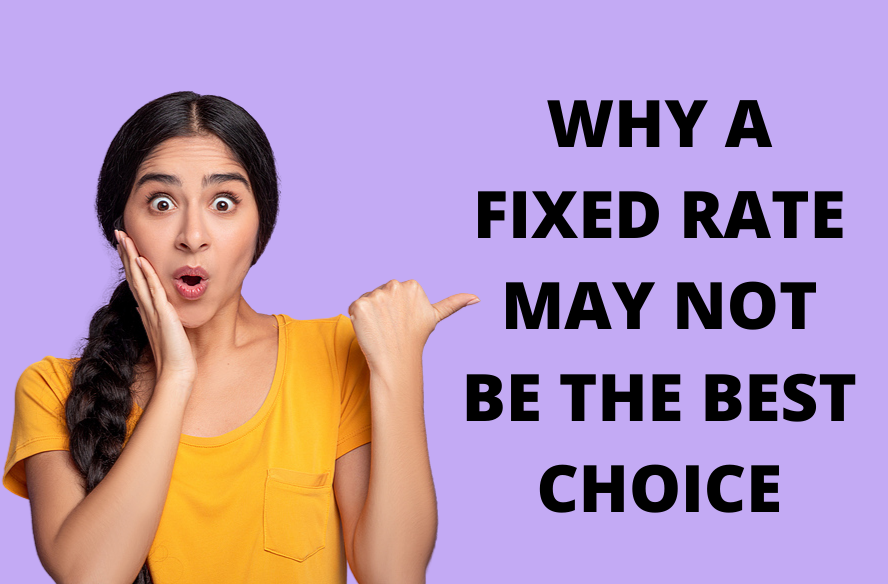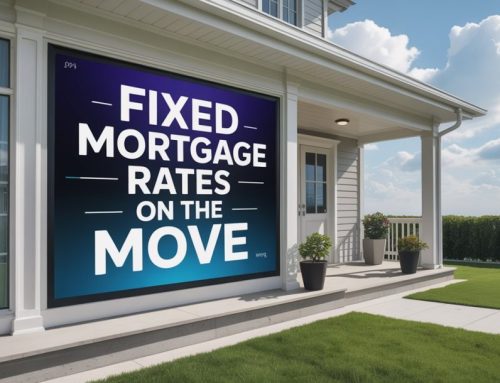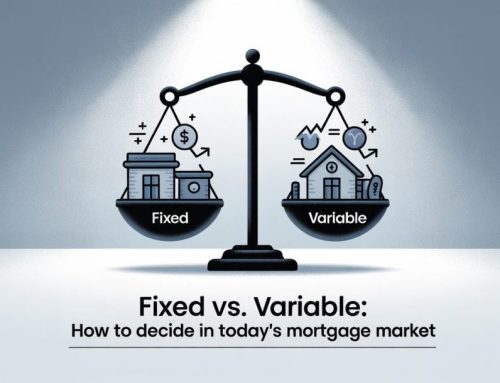Mortgage rates are always a hot topic of conversation, especially when they are on the move. As fixed mortgage rates have increased by more than 2% since September 2021, the topic is now hotter than ever.
The rapidly increasing rates are leading many to start looking for fixed mortgage rates exclusively. But this can be a costly move….and I’m not just talking about the rate.
Rates Will Move In Both Directions
When rates are on the rise, many tend to look for the comfort of a fixed rate mortgage. After all, the rate and payment is guaranteed to be the same for the term, usually five years.
But rates will move in both directions over that time.
There has never been a five year period in history where the Bank of Canada has increased their rate, but not decreased within the same five year period. A downward trend is expected to follow the current upward rate trend we’ve been experiencing.
Before we discuss the lower rates to come, we first need to understand why the rates have been increasing so rapidly.
The Reason Behind The Rapid Upward Mortgage Rate Trend
The reason why the Bank of Canada has been so aggressively increasing rates is to bring inflation under control. I’m sure you don’t need me to point out what is happening with the price of gas, groceries, or just about anything else we need to buy. If the Bank of Canada doesn’t take aggressive action, then it won’t just be high mortgage rates that we will need to worry about. It will be high prices on everything else as well. The rate increases are needed to keep our cost of living from spiralling out of control.
The BOC’s Influence On Variable Rates Vs. Fixed
While the Bank of Canada announcements are related to floating rate loans such as variable rate mortgages and HELOCs (Home Equity Line of Credit), fixed mortgage rates are largely influenced by bond yields. While the BOC announcements can affect the yields, this is not always the case.
For example, If they increase their rate by 0.50%, this doesn’t mean that fixed rates will increase by the same amount. In fact, all the expected rate increases from the BOC have already been priced into the bond yields, which means they are already priced into the current fixed mortgage rates.
This doesn’t mean that fixed mortgage rates will not increase further. But it doesn’t necessarily mean that more increases from the BOC will spark another wave of fixed mortgage rate increases.
It’s also possible that fixed rates can move in the opposite direction. Possible, but not that common. Back at the start of the pandemic in March of 2020, the Bank of Canada made a rare unscheduled rate announcement where they dropped their key policy rate (prime rate) by 0.50%. At the same time, the bond yields started to soar based on news coming out of the US. This resulted in fixed mortgage rates jumping immediately by as much as 0.25%. It was a prime example that fixed mortgage rates can move in the opposite direction of the Bank of Canada.
What Is Expected From The Bank Of Canada This Year?
The BOC is expected to increase their key policy rate by another 1.00% to 1.50% which would bring the prime rate to 4.20% – 4.70%. The key policy, or overnight rate, is what mortgage lenders use to set their prime rates. When the Bank increases its rate, mortgage lenders will match (with few exceptions).
It’s this rapid and aggressive movement from the Bank of Canada that is scaring many into locking into a fixed rate. The BOC is committed to doing whatever it takes to bring inflation under control. This will come at the expense of the economy, which is expected to force the economy into recession.
Once their inflationary goals have been achieved their focus will turn to the economy.
At that time, the BOC will need to lower rates to stimulate demand. The faster and more aggressive they are with their increases, the sooner and more aggressive they will need to get with their expected rate drops to follow. These are expected to happen at some point in 2024. At that time, both fixed and variable rate are expected to fall.
Fixed Rates Are At A 12 Year High
Fixed mortgage rates have now reached their highest since 2010. While there are still 5 year fixed rates as low as 3.64% in some cases, most mortgage lenders are in the mid to high 4% range. It’s possible that these could climb to more than 5% by early summer.
When rates start to drop, anyone choosing a fixed rate mortgage today will be looking to switch to a lower rate. This is exactly what happened when rates unexpectedly plummeted in 2020 which was courtesy of the pandemic. This wasn’t something that we could have predicted, otherwise everyone would have been choosing a variable in previous years. However, there wasn’t much difference between fixed and variable rates at the time. In fact, variable rate mortgages were higher than their fixed rate alternatives in some cases. Fixed rates made more sense based on what was known at the time.
While the pandemic couldn’t have been predicted, the expected recession is pretty much imminent.
The Harsh Reality With Breaking A Fixed Rate Mortgage
There is nothing wrong with choosing a fixed rate. But it’s important to understand that the penalties to break your mortgage early can be harsh.
The penalty to break a fixed rate mortgage is almost always the higher of three months interest or the Interest Rate Differential (IRD). The IRD is the difference between the rate you are paying and the new rate the lender would have to re-lend the money out at. The simplest way to explain it is if the rate at the time you break is higher than what you are paying, then you would pay 3 months interest. If it’s lower, you would pay the IRD. The calculation is more complex than that, but that’s the basic concept of it.
It doesn’t always work this way, however.
While the wording is very similar among all mortgage lenders, the way in which the IRD is calculated can vary drastically from one lender to the next.
For example, the penalty to break a fixed rate mortgage with a major bank can be as much as 900% higher than most non-bank lenders. This could mean the difference between a $5,000 penalty or a $45,000 penalty. I’m not saying that there will be this much difference in every situation, but I wanted to illustrate how big it can be.
The difference can be substantial.
You Don’t Plan On Breaking Your Mortgage, Right?
Most people who enter into 5 year fixed mortgages are 100% convinced they will not break their mortgage before the end of the term. Yet so many people do. More than 50% actually. It can be for a number of reasons, many of which are unfavourable:
- Loss of work
- Divorce
- Disability
- Personal injury
- Legal matters
- Family issues, etc.
None of these can be planned for.
While there are a number of reasons why people break early, one of the biggest is to switch to a lower rate.
Many are not aware that the more rates drop below your current fixed rate, the higher your penalty, regardless of which lender you are with.
Even with ‘fair penalty lenders’, the penalty to break a fixed rate mortgage can be substantial if rates drop low enough.
And there is a lot of room for them to fall from where they are today.
This can make switching to a lower rate cost-prohibitive, regardless of whether you are with a fair penalty lender or not. There are many who experienced this from mid-2020 to late summer 2021 when fixed rates were at their all-time low.
The only way to guarantee you a specific penalty is to go with a variable rate mortgage.
This doesn’t mean that EVERYONE should be going variable and what is right for one person might not be right for the next. But before making your decision, I would highly recommend reading the following of my blogs:
How Many Rate Hikes Will It Take To Lose With a Variable Rate?
Are Fixed Mortgage Rates Now The Way To Go?
Should You Convert Your Variable Rate Into A Fixed?
The Ultimate Guide To Choosing Fixed Vs. Variable
Conclusion
The Bank of Canada is willing to sacrifice the economy to bring inflation under control. An economic recession is pretty much imminent at this point, which is a solid indicator that mortgage rates will start to fall.
This is expected to happen at some point in 2024.
A variable rate mortgage can still be a great choice. You just need to be prepared for the Bank of Canada’s expected rate increases over the next year. You will then be able to take advantage of the rate decreases to follow and perhaps convert to a lower fixed rate mortgage at that time.
While there is clear evidence that a recession is coming and that mortgage rates will drop at the time, anything can happen and circumstances can change. The war in Ukraine and the COVID pandemic were not events that anyone could have predicted. Yet they have played key roles in the direction of mortgage rates. When it comes to the finance world, mortgage rates included, anything can happen.








Leave A Comment